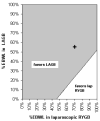Cost-effectiveness analysis of laparoscopic gastric bypass, adjustable gastric banding, and nonoperative weight loss interventions
- PMID: 18069075
- PMCID: PMC2706260
- DOI: 10.1016/j.soard.2007.09.009
Cost-effectiveness analysis of laparoscopic gastric bypass, adjustable gastric banding, and nonoperative weight loss interventions
Abstract
Background: Laparoscopic adjustable gastric banding (LAGB) and laparoscopic Roux-en-Y gastric bypass (LRYGB) are the two most commonly performed bariatric procedures. Although both procedures likely reduce healthcare expenditures related to the resolution of co-morbid conditions, they have different rates of perioperative risks and different rates of associated weight loss. We designed a model to evaluate the incremental cost-effectiveness of these procedures compared with nonoperative weight loss interventions and with each other.
Methods: We used a deterministic, payer-perspective model comparing the lifetime expected costs and outcomes of LAGB, LRYGB, and nonoperative treatment. The major endpoints were survival, health-related quality of life, and weight loss. Life expectancy and lifetime medical costs were calculated across age, gender, and body mass index (BMI) strata using previously published data.
Results: For both men and women, LRYGB and LAGB were cost-effective at <$25,000/quality-adjusted life-year (QALY) even when evaluating the full range of baseline BMI and estimates of adverse outcomes, weight loss, and costs. For base-case scenarios in men (age 35 y, BMI 40 kg/m(2)), the incremental cost-effectiveness was $11,604/QALY for LAGB compared with $18,543/QALY for LRYGB. For base-case scenarios in women (age 35 y, BMI 40 kg/m(2)), the incremental cost-effectiveness was $8878/QALY for LAGB compared with $14,680/QALY for LRYGB.
Conclusion: The modeled cost-effectiveness analysis showed that both operative interventions for morbid obesity, LAGB and RYGB, were cost-effective at <$25,000 and that LAGB was more cost-effective than RYGB for all base-case scenarios.
Figures



Similar articles
-
Cost-Effectiveness Analysis of Bariatric Surgery for Morbid Obesity.Obes Surg. 2018 Aug;28(8):2203-2214. doi: 10.1007/s11695-017-3100-0. Obes Surg. 2018. PMID: 29335933
-
Cost-effectiveness of laparoscopic gastric banding and bypass for morbid obesity.Am J Manag Care. 2010 Jul 1;16(7):e174-87. Am J Manag Care. 2010. PMID: 20645663
-
Laparoscopic adjustable gastric banding versus Roux-en-Y gastric bypass: 5-year results of a prospective randomized trial.Surg Obes Relat Dis. 2007 Mar-Apr;3(2):127-32; discussion 132-3. doi: 10.1016/j.soard.2006.12.005. Epub 2007 Feb 27. Surg Obes Relat Dis. 2007. PMID: 17331805 Clinical Trial.
-
Short-Term Outcomes of Conversion of Failed Gastric Banding to Laparoscopic Sleeve Gastrectomy or Roux-En-Y Gastric Bypass: a Meta-Analysis.Obes Surg. 2019 Feb;29(2):420-425. doi: 10.1007/s11695-018-3538-8. Obes Surg. 2019. PMID: 30293135
-
A review of studies comparing three laparoscopic procedures in bariatric surgery: sleeve gastrectomy, Roux-en-Y gastric bypass and adjustable gastric banding.Obes Surg. 2011 Sep;21(9):1458-68. doi: 10.1007/s11695-011-0390-5. Obes Surg. 2011. PMID: 21455833 Review.
Cited by
-
The cost, quality of life impact, and cost-utility of bariatric surgery in a managed care population.Obes Surg. 2010 Jul;20(7):919-28. doi: 10.1007/s11695-010-0169-0. Obes Surg. 2010. PMID: 20446053
-
Is bariatric surgery an option for women with gynecologic cancer? Examining weight loss counseling practices and training among gynecologic oncology providers.Gynecol Oncol. 2014 Sep;134(3):540-5. doi: 10.1016/j.ygyno.2014.06.006. Epub 2014 Jun 14. Gynecol Oncol. 2014. PMID: 24933102 Free PMC article.
-
The cost-effectiveness of laparoscopic adjustable gastric banding in the morbidly obese adult population of Australia.PLoS One. 2013 May 22;8(5):e64965. doi: 10.1371/journal.pone.0064965. Print 2013. PLoS One. 2013. PMID: 23717680 Free PMC article.
-
Bariatric surgery - can we afford to do it or deny doing it?Frontline Gastroenterol. 2011 Apr;2(2):82-89. doi: 10.1136/fg.2010.002618. Frontline Gastroenterol. 2011. PMID: 23814666 Free PMC article. No abstract available.
-
Cost-effectiveness of bariatric surgical procedures for the treatment of severe obesity.Eur J Health Econ. 2014 Apr;15(3):253-63. doi: 10.1007/s10198-013-0472-5. Epub 2013 Mar 24. Eur J Health Econ. 2014. PMID: 23526126 Free PMC article.
References
-
- Mokdad A, Serdula M, Dietz W, Bowman B, Marks J, Koplan J. The continuing epidemic of obesity in the United States. JAMA. 2000;284:1650–1. - PubMed
-
- Finkelstein EA, Fiebelkorn IC, Wang G. National medical spending attributable to overweight and obesity: how much, and who’s paying? Health Aff (Millwood) 2003 Jan-Jun;Suppl:W3-219–226. - PubMed
-
- McTigue KM, Harris R, Hemphill B, et al. Screening and interventions for obesity in adults: summary of the evidence for the U.S. Preventive Services Task Force. Ann Intern Med. 2003;139:933–49. - PubMed
-
- Buchwald H, Avidor Y, Braunwald E, et al. Bariatric surgery: a systematic review and meta-analysis. JAMA. 2004;292:1724–37. - PubMed
-
- Craig BM, Tseng DS. Cost-effectiveness of gastric bypass for severe obesity. Am J Med. 2002;113:491–8. - PubMed
MeSH terms
Grants and funding
LinkOut - more resources
Full Text Sources
Medical
Research Materials

